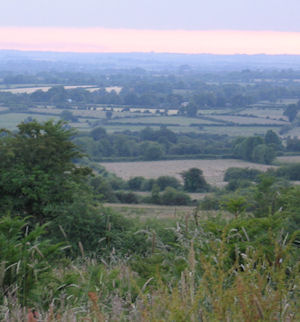| Home | ||||||||||||||||||||||||||||||||||
| SLIABH BÁN / history | ||||||||||||||||||||||||||||||||||
|
Sliabh Bán and
its southern ridge Fairymount are both an intrinsic part of the Cruachan
complex of archaeological sites near Tulsk, identified as
the site the traditional capital of Connacht, and
are named in the
epic Táin Bó Cúalnge. The mountain has at least seven ring forts on its slopes, two near the summit. Most of these are now visible only on the old maps, as Coillte planted spruce trees on and around them in the period before this became illegal. Further testimony that the mountain was a place of religious significance in prehistoric and mythic times was uncovered by the local people who erected the cross on the summit in the Marian year of 1950; they discovered ancient bones when they were digging the foundations. Sliabh Bán is threaded by an ancient walkway which connects Cloontuskert Abbey on its east, and Lisonuffy Abbey to its west. It was used by monks passing between the two establishments. In 2003 the path was cleared and made passable again in accordance with the 1840 map of the area, with the help of a FAS Community work scheme. Coillte supported the FAS scheme that cleared the monastic track. However they have recently destroyed a section of it once again by widening an access road. There is a 17th century Mass Rock on Sliabh Bán, and in 2002/3 a route to it was cleared by a FAS scheme in association with the local community. A photo and directions to it are available in the ‘Walking Through Time’ pamphlet. It is sited very near to a proposed turbine and it it doubtful whether it would survive the construction process: its peace and sanctity certainly would not. The mountain has always been a place of natural sacredness and formal religious significance. In 1950 local people built a cross on its summit, to commemorate the Marian Year; and within the last decade the same local community refurbished the cross and organised lighting for it at night. The conservation schemes and improvements to Sliabh Bán have in recent years been coordinated by the The Sliabh Bán Eco-Tourism Project (SLIABH BÁNETP). This was initiated in 1996 with the aim of improving public access to Sliabh Bán and developing it as a sustainable recreational, cultural and bio-diversity resource. A study undertaken by Environmental West Consultants asserted that Sliabh Bán has ‘immense potential for the development of a walking amenity that would give people direct access to local history, archaeology and natural history’. With the active involvement of Coillte, Arigna Leader, FAS and local community groups, the SLIABH BÁN Project planned, designed, cleared, developed, mapped and signposted four circular walks around Sliabh Bán. One of these follows the ancient monastic track. These recreational walks include fourteen viewing points, with seating made by local craftsmen. |
|||||||||||||||||||||||||||||||||
| Home | ||||||||||||||||||||||||||||||||||
